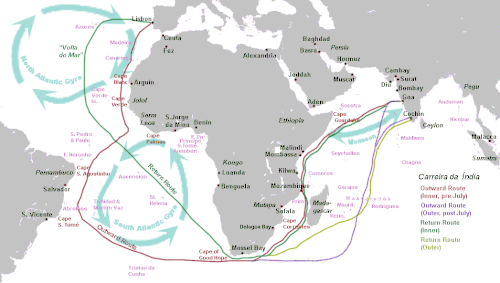"Strategy is the art of making use of time and space."
— Napoleon Bonaparte, French Military Leader
In the 15th century, European powers faced a dilemma that would reshape the world order. The Silk Road, the centuries-old artery of trade connecting China to Europe, was becoming increasingly unreliable. Controlled by empires entrenched in the Middle East and Central Asia, the overland route was no longer a secure lifeline. Political instability, hostile territories, and exorbitant tariffs made it a poor bet for trade. The Europeans were caught in a bind: remain dependent on this dwindling, fragile path, or innovate their way out.
The solution, unsurprisingly, came from the sea. The Portuguese, Spanish, Dutch, and British, driven by a fierce need to secure more lucrative trade routes, embarked on the Age of Exploration. Their goal was clear—find maritime routes to India and the Far East, bypassing the land-based choke points that had stifled trade and inflamed geopolitical tensions.
This wasn’t just about finding a new way to ship spices and silk. It was about fundamentally altering the structure of global commerce. European powers, through maritime exploration, began to control their own shipping lanes, bypassing the monopolistic control of the Silk Road and opening new frontiers for trade. For the first time in history, they could chart their own course in a global economy, reshaping international trade and establishing global dominance for those who controlled the seas.
Today, a modern-day geopolitical chokepoint, the Strait of Malacca, plays a critical role in global energy transportation, not just for China but for key U.S. allies like Japan, South Korea, and Taiwan. With these countries depending on the Strait for 50-60% of their energy imports, the vulnerabilities of this route are becoming increasingly apparent. Rising tensions in the South China Sea, coupled with China's growing regional ambitions, have made the Strait a source of concern, especially as the region becomes more militarized. For the United States, ensuring the security of its allies’ energy flows is just as critical as safeguarding its own energy security. And, much like the explorers of the Age of Exploration, the U.S. is responding with a new, innovative strategy: the Alaska LNG project.
The U.S. is positioning itself to mitigate the risks posed by the volatile Strait of Malacca by offering a more secure and reliable energy route through Alaska’s LNG terminal. This alternative corridor, which bypasses the choke points influenced by China, offers a significant opportunity to strengthen U.S. energy dominance and secure the energy needs of key allies in East Asia. The Alaska LNG project, with its promise of stable energy supplies, is rapidly becoming a cornerstone of the U.S. strategy to protect energy flows in the region and strengthen its geopolitical alliances.
The investments in Alaska LNG are not just about energy diversification; they represent a strategic pivot by several key countries in East Asia. Japan, South Korea, Taiwan, and the Philippines are redirecting investments toward the Alaska LNG project to mitigate the risks associated with their traditional reliance on the Strait of Malacca. By seeking alternatives to the increasingly volatile maritime routes in the China Sea, these nations are positioning themselves to safeguard their energy security and reduce exposure to potential disruptions caused by regional conflicts.
Keep reading with a 7-day free trial
Subscribe to The Monetary Skeptic to keep reading this post and get 7 days of free access to the full post archives.






